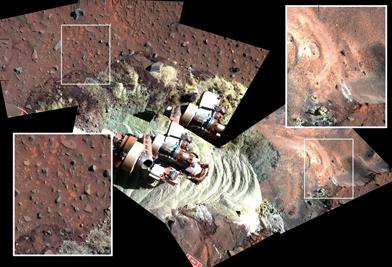Module 2 Summary
1. Module 2 Summary
Module 2 Summary

Courtesy NASA/JPL-Caltech
Stitching together images taken from different positions, or even different cameras, takes considerable computing power. Matching points on the images have to be found and the sizes have to be adjusted to fit the pieces together. Some images even need to be rotated. The trigonometric functions you studied play a big role in photo software.
In this module you investigated the following question:
- How can trigonometry be used to measure distances indirectly?
You learned about the sine, cosine, and tangent function for angles greater than 90°. You saw how using a circle to define the functions makes it easy to determine the signs (positive or negative) of the function values from 0° to 360°.
You learned how to determine the number of solutions to simple linear trigonometric equations, like cosine θ = 0.14. You also learned how to find all possible solutions to the same types of equations for 0° ≤ θ ≤ 360°.
You learned how to find the values of the trigonometric functions for special angles like 0°, 30°, 45°, 60°, and 90°. You also learned to find the values when the angle was given by specifying a point on the terminal arm of the angle.
You learned to use the sine law and the cosine law to solve problems involving sides or angles of triangles.
Module 2: Trigonometry, Video Summary is a look back at the math you explored. Watch Module 2: Trigonometry, Video Summary to review what you learned and to confirm your answers to the module question.
The following table summarizes the learning outcomes in Module 2. Complete a table like this one by listing the activities you undertook to address each outcome. You can use Module 2: Trigonometry, Video Summary to help you recall major activities. You can also revisit the lessons.
![]() Save a copy of your completed table in your course folder for review.
Save a copy of your completed table in your course folder for review.
| Outcomes for This Module | Learning Activities in Which I Addressed This Outcome |
Describe how cosine, sine, and tangent are defined for angles greater than 90°. |
|
Determine the sign (positive or negative) of cosine, sine, and tangent for any angle without using your calculator. |
|
State the number of solutions to a linear trigonometric equation, such as sin θ = 0.4. |
|
Explain how symmetry can be used to solve equations of the form sin θ = k, where −1 ≤ k ≤ 1. |
|
Solve equations of the form sin θ = k, where −1 ≤ k ≤ 1 (for each of sine, cosine, and tangent). |
|
Determine by hand the cosine, sine, or tangent of 0°, 30°, 45°, 60°, and 90° angles, and their reflections in the other three quadrants of the Cartesian plane. |
|
Determine the cosine, sine, or tangent of angles given the coordinates of a point on the terminal arm. |
|
Use the sine law to solve for sides or angles in oblique triangles. |
|
| Determine how many solutions are possible in a situation called the ambiguous case with the sine law. | |
Use the cosine law to solve for sides or angles in oblique triangles. |
